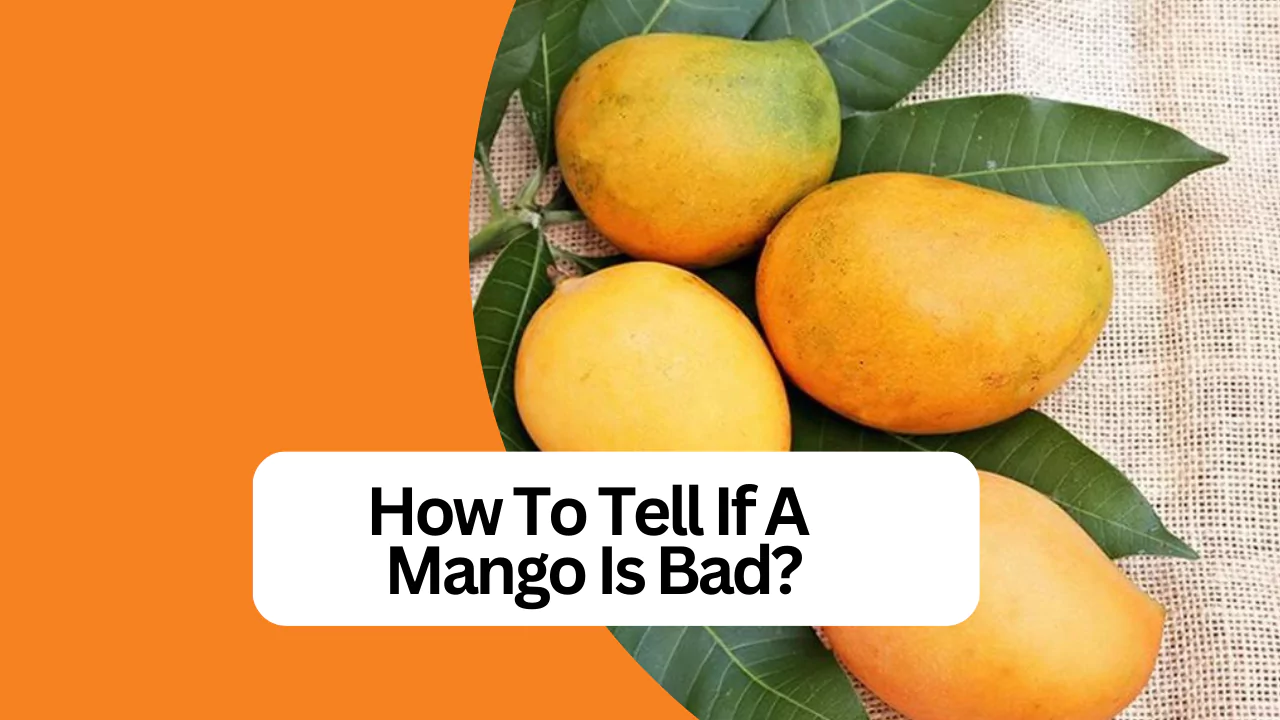Everyone adores mangos, which are delectable tropical fruits. Everyone wants to keep mangos for a more extended period now that mango season has arrived. Conversely, some mangos are intimidating since they go readily due to the humid environment. As a result, many are looking for information on identifying a poor mango to keep them carefree for months.
This article will go over every important aspect regarding the shelf life of mangos when they go bad, how to tell if they are rotten, and which kinds of mangos you should avoid.
Let’s look at some mango essentials now without further ado.
What Is A Mango’s Shelf Life?
The shelf life of mango can vary depending on various factors such as the ripeness of the fruit at the time of purchase, storage conditions, and the variety of mango. Generally, an unripe mango can last about 1-2 weeks when stored at room temperature.
However, if you want to extend its shelf life, you can store it in the refrigerator, which can help slow the ripening process and keep it fresh for 2-3 weeks. It is important to note that once a mango is ripe, it should be consumed within a few days to ensure optimal taste and quality. Proper storage and handling are crucial in maintaining the freshness and extending the shelf life of mango.
The Difference Between An Overripe Mango And A Mango Gone Bad
The difference between an overripe mango and a mango gone bad lies in their stages of ripeness and the resulting changes in texture, taste, and appearance. While an overripe mango is still edible and may have a softer texture and sweeter taste, a mango that has gone bad is no longer suitable for consumption due to spoilage.
An overripe mango occurs when the fruit has been left to ripen for an extended period beyond its optimal stage. As a mango ripens, it goes through various stages, from being unripe and green to fully ripe. Overripeness happens when the fruit is left on the tree or stored for too long after reaching its peak ripeness. During this process, the mango’s skin may turn yellow or even develop brown spots, indicating that it is becoming overripe.
When an overripe mango is cut open, its flesh may be mushy and soft. The texture resembles a very ripe banana or even baby food. The flavor of an overripe mango tends to be sweeter than a perfectly ripe one, but it can also have a slightly fermented taste. Despite these changes, an overripe mango is still safe to eat if it does not show spoilage.
On the other hand, a mango that has gone bad has undergone spoilage due to factors such as improper storage conditions or exposure to bacteria or fungi. When a mango goes bad, its appearance and texture change significantly. The skin may become discolored, shriveled, or covered in mold. The flesh of a spoiled mango can turn brown or black and develop an unpleasant odor.
How To Tell If A Mango Is Bad?
Knowing whether the mango is bad is essential, as eating bad mangos can cause illness. Hence, here is how you can tell if a mango is gone bad or not:
Visual Inspection
One of the easiest ways to tell if a mango is bad is by visually inspecting mango colors. A fresh and ripe mango should have vibrant colors, such as a combination of green, yellow, and red. The skin should be smooth and free from any blemishes or bruises. If you notice any dark spots, mold growth, or shriveled skin on the mango, it is likely spoiled and should be discarded.
Texture
Another essential factor to consider when determining the freshness of a mango is its texture. A ripe mango should feel slightly soft when gently squeezed, similar to the texture of a ripe peach or avocado. However, if the mango feels excessively mushy or has a stringy texture, it may be overripe or starting to rot.
Smell
The aroma of mango can also provide valuable information about its freshness. A ripe mango should have a sweet and fragrant smell characteristic of the fruit. If you detect any sour or unpleasant odors coming from the mango, it may indicate that it has gone bad.
Taste
While visual inspection and texture can give you some clues about the quality of a mango, the most definitive way to determine if it is bad is by tasting it. A fresh, ripe mango should have a sweet, juicy flavor with no off-putting taste. If the mango tastes sour, fermented, or has an unusual flavor, it is likely spoiled and should not be consumed.
Mold
Mold growth is a clear sign that mango is bad and should be discarded immediately. If you notice any fuzzy or greenish-black patches on the mango’s skin or flesh, it indicates mold. Mold can produce harmful toxins if ingested, so avoiding moldy mangoes is crucial.
7 Signs A Mango Is Going Bad
Several signs indicate a mango is going bad. It is essential to identify these signs to ensure that you consume fresh and safe mangoes. Here are seven signs to look out for:
Appearance
One of the first signs that mango is going bad is a change in its appearance. A ripe mango color has smooth, unblemished skin with vibrant colors ranging from green to yellow or red, depending on the variety. The skin may develop dark spots, wrinkles, or discoloration as the fruit spoils. These changes in appearance indicate that the mango is no longer fresh and may have started to decay.
Texture
Another sign of a mango going bad is a change in its texture. A ripe mango should have firm flesh that gives slightly when pressed but remains intact. If you notice that the flesh has become excessively soft or mushy, it indicates that the fruit is overripe and may have started to rot. Additionally, if you feel any sliminess or stickiness on the surface of the mango, it is best to discard it, as it could be a sign of bacterial growth.
Smell
The smell of mango can also provide clues about its freshness. A ripe mango usually has a sweet and fragrant aroma. However, as it spoils, the smell may become unpleasant or sour. If you detect any off-putting odors from the mango, it is likely past its prime and should not be consumed.
Mold
Mold growth is a clear indication that mango is going bad. Mold can appear as fuzzy patches or spots on the fruit’s skin. It can range in color from white to green or black. If you notice any mold on a mango, it is best to discard it immediately, as consuming moldy fruit can lead to food poisoning or allergic reactions.
Taste
A fresh mango should have a sweet and juicy taste. However, if you bite into a mango and notice a sour or fermented flavor, it is a sign that the fruit has started to spoil. The taste of an overripe or rotten mango can be unpleasant and may cause digestive discomfort if consumed.
Juice
When a mango goes bad, it may leak juice or become excessively watery. This can be observed by feeling the moisture on the skin or noticing a pool of liquid around the fruit. Excessive juice production often results from the fruit breaking down internally, indicating that it is no longer fresh.
The texture of the Seed
Lastly, examining the texture of the mango seed can provide insight into its freshness. A fresh mango seed should be firm and intact. If the Seed has become soft or mushy, it suggests that the fruit is past its prime and should not be consumed.
How To Choose The Best Mango At The Store?
Choosing the best mango at the store can be daunting, as there are various factors to consider, such as ripeness, appearance, and aroma. Here is how to pick a mango:
Check for external appearance.
Start by examining the mango’s external appearance. Look for mango with smooth, unblemished skin without bruises or dark spots. The color of the skin is only sometimes an indicator of ripeness, as it varies depending on the variety. However, vibrant color is generally a good sign.
Assess firmness
Gently squeeze the mango to determine its firmness. A ripe mango should have a slight give but be soft and smooth enough when pressed. Avoid selecting mangos that are excessively hard or overly soft, as they may not be ripe or could be overripe.
Consider fragrance
Smell the stem end of the mango to assess its aroma. A ripe mango will have a sweet and fragrant smell, indicating that it is ready to eat. It may not be ripe if there is no aroma or if it smells sour or fermented.
Weight
Pick up the mango and feel its weight in your hand. A ripe mango will feel heavier compared to an unripe one of similar size. This is because as mangos ripen, they accumulate more moisture content.
Variety
Different varieties of mangoes have different flavors and textures. Some popular varieties include Alphonso, Ataulfo (also known as Honey Mango), Tommy Atkins, Kent, and Keitt. Research the characteristics of different varieties to find one that suits your taste preferences.
Ripening stage
Consider whether you need a mango that is ready to eat immediately or if you prefer one that will ripen over a few days at home. If you need a mango for immediate consumption, choose one already ripe. However, select a slightly underripe mango if you prefer to let it ripen at home.
Ask for assistance
If you are unsure about selecting the best mango, ask the store staff for assistance. They may know the different varieties and can help you choose a delicious ripe mango.
The Best Way To Store Mangoes
Here are some of the best ways to store mangoes:
The best way to store mangoes is to follow a few simple steps that will help maintain their freshness and flavor for as long as possible. Proper storage techniques can prevent the mangoes from overripening, becoming mushy, or developing mold. Here are some guidelines to ensure optimal storage of mangoes:
Choose ripe but firm mangoes.
When selecting mangoes for storage, choose ones that are slightly soft to the touch but firm. Avoid too hard or soft mangoes, as they may not ripen properly or may already be overripe.
Keep them at room temperature.
Mangoes should be stored at room temperature until they reach the desired level of ripeness. Placing them in a paper bag can help speed up the ripening process. Avoid storing mangoes in the refrigerator before they are fully ripe, as this can cause them to lose flavor and develop a rubbery texture.
Separate from other fruits
Mangoes produce ethylene gas, accelerating the ripening process of other fruits nearby. To prevent this, store mangoes separately from other fruits and vegetables.
Refrigerate when fully ripe.
Once the mangoes have reached the desired level of ripeness, they can be stored in the refrigerator to prolong their shelf life. Place them in a plastic bag or an airtight container to prevent moisture loss and keep them fresh for up to five days.
Avoid exposure to sunlight.
Mangoes should be kept away from direct sunlight, as excessive heat can cause them to spoil quickly. Store them in a cool, dry place away from windows or other heat sources.
Handle with care
Mangoes have delicate skin that bruises easily. Handle them gently to avoid any damage that could lead to spoilage.
Check for signs of spoilage.
Regularly inspect your stored mangoes for any signs of mold, decay, or soft spots. If you notice any, remove the affected mangoes immediately to prevent the spread of spoilage.
How To Store Unripe Mangoes?
Storing unripe mangoes properly ensures that they ripen evenly and maintain their quality. Here are some steps to follow when storing unripe mangoes:
- Select firm, unripe mangoes for storage. Look for mangoes that have green skin with no blemishes or bruises. Avoid mangoes that are too hard or have started to soften.
- Unripe mangoes should be stored at room temperature until they ripen. Place them in a cool and dry area away from direct sunlight. Avoid storing them in the refrigerator, which can hinder the ripening process.
- If you have multiple unripe mangoes, keeping them separate from each other is essential. This prevents them from releasing ethylene gas, which can speed up the ripening process and cause them to spoil quickly.
- Check the mangoes daily to monitor their ripening progress. Gently press the skin with your thumb – if it gives slightly, it indicates that the mango is starting to ripen. Once they reach the desired level of ripeness, you can store them in the refrigerator.
- Once the mangoes are ripe, you can store them in the refrigerator to prolong their shelf life. Place them in a plastic bag or airtight container to prevent moisture loss and keep them fresh for longer.
- Ripe mangoes should be consumed within a few days of refrigeration to enjoy their optimal flavor and texture. If you don’t plan on using them immediately, consider freezing them for later use.
- If you have an abundance of unripe mangoes and want to store them for an extended period, you can freeze them. Peel and slice the mangoes, then place the pieces in a freezer-safe bag or container. Label them with the date and store them in the freezer for up to six months.
- To thaw frozen mangoes, transfer them from the freezer to the refrigerator and let them defrost slowly overnight. Avoid thawing them at room temperature or using a microwave, as it can affect their texture.
How To Store Ripe Mangoes?
Here is how you can easily store ripe mangoes by following the steps mentioned below:
- Select fully ripe mangoes with a slight give when gently squeezed.
- Store ripe mangoes at room temperature to allow them to continue ripening and develop their full flavor.
- Keep the mangoes away from direct sunlight, which can cause them to over-ripen or spoil.
- Mangoes produce ethylene gas, which can speed up the ripening process of other fruits. To prevent this, store mangoes separately from other fruits.
- Avoid refrigerating ripe mangoes immediately, as it can affect their taste and texture. Only refrigerate them if you want to extend their shelf life.
- If you have too many ripe mangoes or want to prolong their freshness, place them in a plastic bag and store them in the refrigerator. This will slow down the ripening process.
- Ripe mangoes should be consumed for the best taste and quality within a few days.
How To Store A Mango In The Freezer?
Storing mangoes in the freezer is a great way to preserve their freshness and enjoy them later. Freezing mangoes can be done in a few simple steps, ensuring they retain flavor and texture.
Here is a detailed guide on how to store a mango in the freezer:
- Start by washing the mango thoroughly under running water to remove any dirt or residue.
- Peel the mango using a knife or a vegetable peeler. Once peeled, slice the mango into desired shapes and sizes.
- Cut around the pit of the mango and separate the flesh from it. Discard the pit.
- If desired, you can prepare syrup by dissolving sugar in water. This step is optional and can help maintain the texture and flavor of the mango.
- Transfer the sliced mangoes into a freezer-safe container or a ziplock bag. Make sure to leave some space at the top for expansion during freezing.
- Pour syrup over the mango slices in the container if you prepare syrup. This will help prevent freezer burn and maintain the quality of the fruit.
- Seal the container tightly or close the ziplock bag securely. Label it with the date of freezing to keep track of its freshness.
- Place the container in the freezer on a flat surface to prevent any spillage or damage.
- Mangoes can be stored in the freezer for up to 6 months without significantly losing quality. However, for optimal taste and texture, consuming them within 2-3 months is recommended.
Can You Eat Wrinkled Mangoes?
Yes, you can eat wrinkled mangoes. While the appearance of mango may change as it ripens and ages, the wrinkling of the skin does not necessarily indicate that the fruit is spoiled or inedible. Some people prefer to eat slightly wrinkled mangoes as they believe it enhances the sweetness and flavor. The texture of a wrinkled mango may be softer than a firm one, but it can still be enjoyed by cutting away any spoiled or discolored parts. It is important to note that if the mango has an unpleasant odor or shows signs of mold or rot, it should not be consumed. Therefore, as long as the wrinkled mango is not spoiled or showing signs of decay, it is safe to eat.
FAQs
Is It Harmful To Eat Spoiled Mango?
Eating spoiled mango can be harmful as it may contain harmful bacteria or molds that can cause food poisoning or other health issues. It is essential to properly store and consume fresh mangoes to avoid any potential risks.
How To Prevent Mango From Going Bad Faster?
To prevent mango from going bad faster, store it in the refrigerator, wrap it in a paper towel to absorb excess moisture, and avoid storing it near other fruits that release ethylene gas.
How To Choose Delicious And High-Quality Mangoes?
To choose delicious and high-quality mangoes, look for fruits that are firm yet slightly yielding to gentle pressure, have a sweet aroma at the stem end, and exhibit vibrant colors. Additionally, consider the variety of mango, its origin, and any visible signs of damage or ripeness indicators.
If Mangoes Are Slightly Brown And Soft Inside, Have They Gone Bad?
If mangoes are slightly brown and soft inside, it indicates that they have gone bad. The browning and softening of the flesh are signs of overripeness or spoilage.
Can I Eat A Mango With Dark, White Spots On It?
No, eating a mango with dark, white spots on it is not recommended, as it may indicate spoilage or mold growth. It is best to discard such mangoes to avoid any potential health risks.
If The Mango Has White Spots On The Inside Flesh, Has It Gone Bad?
The white air spots inside a mango may be unappetizing, but they’re certainly not an indicator of rotten or overripe fruit.
How Can You Tell If Your Pickled Mango Has Gone Bad?
To determine if your pickled mango has gone bad, you can look for signs such as color, texture, smell, and taste changes. If the mango appears discolored, slimy, has a foul odor, or tastes off, it is likely spoiled and should not be consumed.
Do Fizzy Mangoes Go Bad?
Fizzy mangoes can only go well if stored correctly or past their expiration date. Before consuming them, it is essential to check for signs of spoilage, such as mold, off smells, or a change in texture.
Why Do Mangoes Taste Like Gasoline?
The mangoes are injected with calcium carbide, which releases acetylene gas when it comes into contact with moisture.
Why Does My Stomach Hurt After Eating A Mango?
Its excessive consumption can cause stomach upset or diarrhea. It is often seen that many people eat mangoes at night, but doing so spoils your digestive system.
Conclusion
In conclusion, determining whether a mango is bad requires carefully examining its physical appearance, smell, and texture. Considering these factors, one can quickly identify signs of spoilage and avoid consuming a rotten mango.






